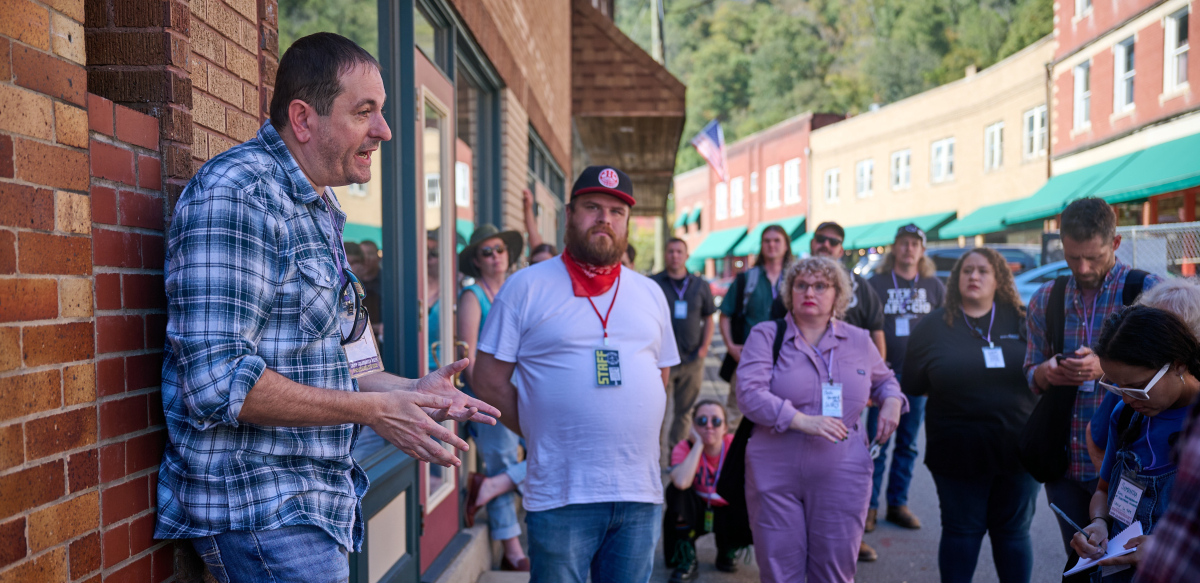Camp Solidarity Connects Labor’s Past and Present in West Virginia

Chuck Keeney, great-grandson of Mine Workers leader Frank Keeney, led a walking tour of historic downtown Matewan during Camp Solidarity. Bullet holes from the famous shoot-out between the Baldwin-Felts mine guards and the miners are still visible on some of the buildings. Photo: Dylan Vidovich
Matewan, West Virginia, scene of an historic gun battle between striking coal miners and mine guards 100 years ago, was recently the site of a unique labor gathering. Camp Solidarity was sponsored by the West Virginia Mine Wars Museum to “build worker power where unions were born.” The idea was to bring labor’s past and labor’s present together.
Eighty union activists from around the U.S. attended the two-day event in October, which included workshops, panel discussions, and walking tours of the battle site and the Museum.
The workshops targeted today’s issues: organizing campaigns, collective bargaining, and engaging members for the long term. Another theme was how to succeed in right-to-work and at-will environments. Dave Coker, president of the Professional Fire Fighters of Greensboro, North Carolina, and a member of the Museum’s board, described how his local has developed and maintained union solidarity in one of the toughest environments for unions.
Panel discussions focused on why and how we tell our stories, and how those stories can help labor activists today. One of those stories was personified by Haeden Wright, whose coal miner husband participated in the recent 23-month long Warrior Met strike by the Mine Workers (UMWA) in Alabama. Wright served as the UMWA Auxiliary President during the strike, organizing mutual aid efforts such as a strike pantry and Solidarity Santa.
Walking tours of Matewan were guided by Chuck Keeney, one of the Museum’s founders and great-grandson of UMWA leader Frank Keeney. Frank Keeney was the “generalissimo” of the 10,000 armed miners that marched on Blair Mountain in 1921. The march was triggered when Matewan’s Sheriff Sid Hatfield was murdered by mine guards as he ascended the courthouse steps to defend himself against charges related to the shootout.
‘A HUMBLING EXPERIENCE’
The very name “Camp Solidarity” honored the original camp that UMWA members operated during their 10-month strike against Pittston Coal in 1989-1990. The first Camp Solidarity housed and fed more than 30,000 union supporters who came from all across the nation to show solidarity with the striking miners.
The new Camp Solidarity ended with the Red Bandana Ceremony, led by life-long Matewan resident Wilma Steele. Steele told camp participants how during the Mine Wars, miners wore red bandanas around their neck to identify themselves to their union brothers—one origin of the term “redneck.” Striking West Virginia teachers again donned red bandanas during the Red for Ed demonstrations in 2018, another example of the continuity between yesterday’s and today’s struggles.
“For union members to come and walk the same streets as Mother Jones, Sid Hatfield, and Frank Keeney, those heroes of labor history, is a humbling experience,” said Coker. “Unions give working people the opportunity to build a decent life. It's critically important that we preserve the history and figure out how to pass it down to members that are coming behind us.”
Chris Mark is a former UMWA coal miner and a mine safety specialist. He lives in Pittsburgh. Check out a video recap of the event on YouTube.





